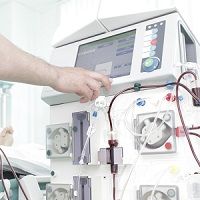Hospice Care Improves End-of-Life Care for Patients who Stop Dialysis
The results of a new survey regarding quality of care for end stage renal disease patients raise questions about how to improve the quality of end-of-life care.

In a new patient survey, family members of patients with end-stage renal disease that are better informed about their end-of-life decisions rate report a higher quality of care.
In the 3369-patient survey, led by Claire A. Richards, PhD, University of Washington, investigators found that patients preparing for end-of-life decisions, improving access to concurrent receipt of dialysis and hospice services aids in improving the quality of end-of-life care for patients undergoing dialysis for end-stage renal disease.
Each patient that participated in the study was treated with maintenance dialysis at 111 US Department of Veterans Affairs medical centers and died between 2009-2015. The mean age of death for the study’s population was 70.6 years.
Also, 98.5% of the study was male and 1701 patients, more than half, had a family member respond to the survey, dubbed the Bereaved Family Survey.
Overall, 937 patients (27.8%) stopped dialysis prior to death, while 2432 patients (72.2%) continued dialysis treatment until death.
“Patients who stopped dialysis were more likely to have been receiving hospice services at the time of death than patients who continued dialysis (544 patients [58.1%] vs 430 patients [17.7%]),” the authors said.
The investigators surveyed family members of patients with end-stage renal disease who were undergoing maintenance dialysis, the adjusted predicted probability of family rating the quality of end-of-life care as excellent was higher for patients who stopped dialysis prior to death (54.9%) than for patients who did not stop dialysis (45.9%).
They also found that patients who did not stop dialysis, receipt of hospice was linked to a higher probability of the patient’s family rating the quality of end-of-life care as excellent (60.5% vs. 40.0%).
“In adjusted analyses, families were more likely to rate overall quality of end-of-life care as excellent if the patient had stopped dialysis (54.9% vs 45.9%; risk difference, 9.0% [95% CI, 3.3-14.8%]; P = .002) or continued to receive dialysis but also received hospice services (60.5% vs 40.0%; risk difference, 20.5% [95% CI, 12.2-28.9%]; P < .001),” the authors wrote.
The findings raise questions as to whether reducing barriers to hospice enrollment for those receiving dialysis could help improve the quality of end-of-life care among patients with end stage renal disease.
In the US, there are about 500,000 patients currently receiving maintenance dialysis for treatment of end-stage renal disease.
According to the investigators, approximately 25% of patients receiving maintenance dialysis for end-stage renal disease eventually halt treatment before death.
The study comes at an opportune time for those suffering from end-stage renal disease as the US Food and Drug Administration (FDA) approved canagliflozin (INVOKANA) last month for the reduction of end-stage kidney disease and cardiovascular events in patients with both type 2 diabetes and chronic kidney disease (CKD).
With the approval, canagliflozin becomes the first drug indicated for diabetic kidney disease in almost 2 decades.
The approval, granted to Janssen Pharmaceutical, was based on the results of the landmark phase 3 CREDENCE trial. The study results, published in April of this year, showed the oral therapy was associated with a 30% reduction in risk to progression of end-stage kidney disease, doubling of serum creatinine, and renal or cardiovascular death among patients with CKD and type 2 diabetes, compared to placebo.
The double-blind study, which included 4401 patients, showed the drug—along with standard care—was associated with a 32% reduction in end-stage kidney disease alone (HR, 0.68; (95% CI, 0.54 — 0.86; P = .0015). Canagliflozin also reduced risk of cardiovascular death and hospitalization for heart failure by 31% (HR, 0.69; 95% CI, 0.57 — 0.83; P = .0001) and major cardiovascular events (MACE) by 20% (HR, 0.80; 95% CI, 0.67 — 0.95; P = .0121).
The study, “Association of Family Ratings of Quality of End-of-Life Care With Stopping Dialysis Treatment and Receipt of Hospice Services,” was published online in JAMA Network Open.